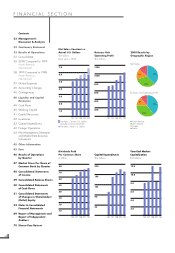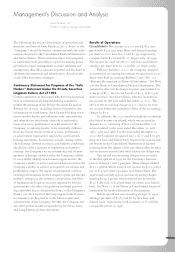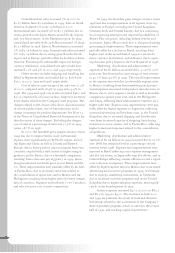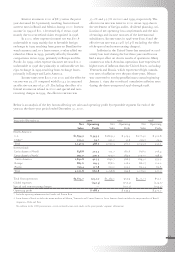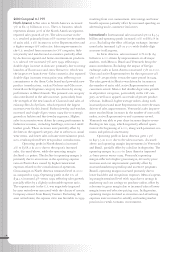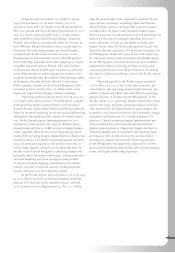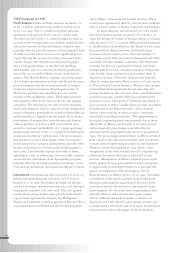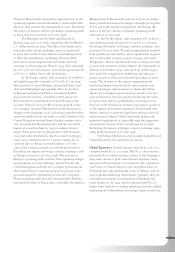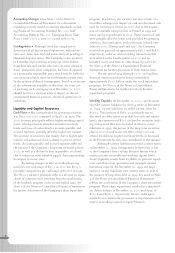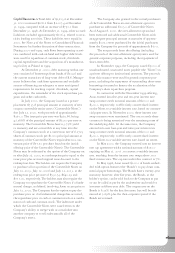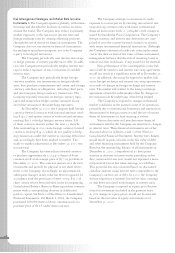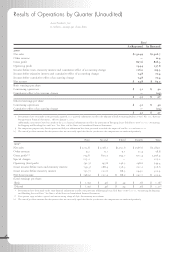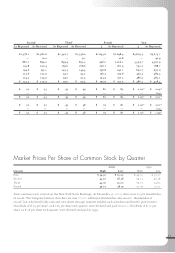Avon 2000 Annual Report Download - page 9
Download and view the complete annual report
Please find page 9 of the 2000 Avon annual report below. You can navigate through the pages in the report by either clicking on the pages listed below, or by using the keyword search tool below to find specific information within the annual report.
However, Brazil made tremendous improvements in the
operating expense ratio attributable to reduced bad debt
expense, sales returns and transportation costs. Excluding
the impact of foreign currency exchange, operating profit
in Latin America increased 22% over 1998.
The Brazilian real devalued significantly in
January 1999 and, as a result, negatively affected Brazil’s
u.s. dollar results in 1999. The effect of exchange rates
was reduced by foreign exchange contracts previously
in place and several actions taken by local management
to offset the devaluation, including a focused effort
directed at vendor negotiations and additional local
sourcing to reduce imports. Brazil’s 1999 sales, although
up over 20% in local currency, were down approximately
20% in u.s. dollars due to the devaluation.
In the Europe region, sales increased 2% to $878.0
and operating profit increased 23% to $126.2 in 1999.
Sales growth in Central Europe, primarily Poland, and
the United Kingdom was partially offset by declines
in Russia, Germany and France. Continued double-
digit increases in units, customers served and active
Representatives contributed to Central Europe’s sales
increase. Poland’s success reflects strong growth in the
cft category, increased Representative retention and a
change in the campaign cycle, including a new brochure
every four weeks versus six weeks in 1998. Growth in the
United Kingdom resulted from a higher average order
size, increased distributorship sales and the successful
launch of a new brochure in 1999 to enhance Avon’s
image. Sales were lower in Russia due to the economic
crisis and ruble devaluation, which occurred in August
1998, and in Germany due to a weak economy. Local
currency sales in Russia increased almost 30% over
1998, with a strong increase in active Representatives.
Excluding the impact of foreign currency exchange, sales
in Europe increased 13% over 1998. The increase in
Europe’s operating profit resulted from operating margin
improvements in Central Europe, mainly Poland, the
United Kingdom and Italy due to higher gross margins
that resulted from a continuing focus on pricing strate-
gies and improved profitability of non-cft categories.
These operating profit increases were partially offset by
continued declines in Russia due to the ruble devaluation.
Management in Russia will continue to focus on market
share growth and improved margins through pricing flex-
ibility and tight expense management. Excluding the
impact of foreign currency exchange, operating profit
increased 31% over 1998.
In the Pacific region, sales increased 16% to $720.1
and operating profit increased 63% to $102.1 in 1999.
Excluding the impact of foreign currency exchange, sales
increased 8% over 1998. The sales improvement resulted
from growth in every market, most significantly in Japan
due to a favorable currency impact in 1999, and in the
Philippines, Taiwan and Australia due to strong increases
in units and customers served. Despite the earthquake in
Taiwan in September 1999, sales were up double-digits
over 1998 due to aggressive marketing and sales pro-
grams, incentive offers and increased spending on adver-
tising. The increase in the region’s operating profit
resulted primarily from the above sales increases and
operating margin improvements in Japan and China.
Japan’s gross margin improved due to product cost sav-
ings initiatives in cft and improved sourcing decisions
for non-cft as well as a profitability screening process
that led to the elimination of many low-margin products
in the apparel and jewelry segments. Additionally, bpr
efforts continue to generate significant savings across all
expense areas in Japan. China’s operating margin also
improved significantly in 1999 reflecting the suspension
of operations for most of the second quarter of 1998.
Excluding the impact of foreign currency exchange, oper-
ating profit increased 53% over 1998.
See Foreign Operations section under Liquidity and
Capital Resources for additional discussion.
Global Expenses > Global expenses were $242.3 in 2000
compared with $255.3 in 1999. The $13.0 decrease was
primarily due to lower expenses related to the Company’s
long-term incentive plan, lower benefit expenses, insur-
ance proceeds received in 2000 related to the 1998 hurri-
cane losses in Central America, the 1999 flood losses in
Venezuela and 1999 earthquake losses in Taiwan, and sav-
ings in global marketing departments, partially offset by
increased investments in information technology and
retail initiatives. In 1999, global expenses were $30.8
higher than 1998 due to higher spending related to global
marketing and information technology system initiatives.
39


